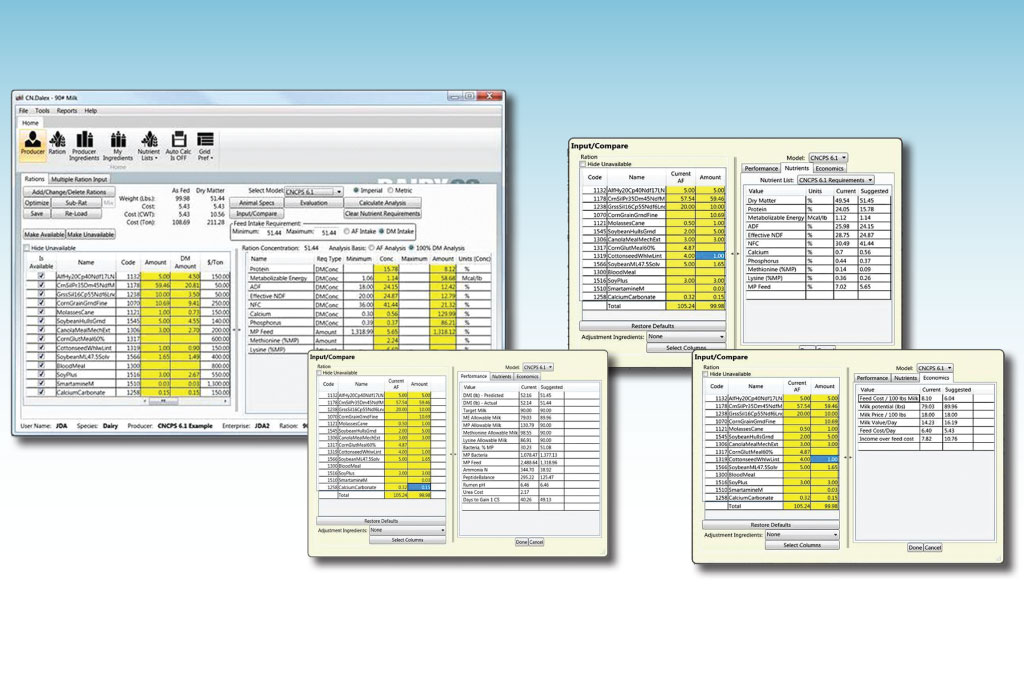In today’s tough economic, environmentally conscious world, a dairy operation needs to run with the utmost precision and efficiency. From purchasing opportunity ingredients to using on-farm forages, to production efficiencies and standard operating procedures, all components must work together to have a successful, profitable and earth-friendly operation.
A successful dairy business builds a foundation that starts with control of the largest on-farm expense – feedstuffs. And it’s not just about buying an ingredient because it’s available or inexpensive.
Ingredient nutrient content and utilization of those nutrients by the herd is a major influence on milk production, reproduction and the environment.
- So, which ingredients should you purchase?
- Can you take advantage of ingredient “fire sales”?
- How will those ingredients influence milk production?
- Can you curb costs yet maintain milk production?
- How can you feed to reduce environmental impact?
A long-standing dairy nutrition model, the Cornell Net Carbohydrate and Protein System , aids nutritionists and producers in the ingredient decision-making process.
In the latest release, Version 6.1, understanding dynamics and biology is as important as predicting nutrient requirements.
Click here or on the image at right to view it at full size in a new window.
During the program overhaul, developers reviewed equations, sub-models and coefficients for errors, made corrections and then validated the equations. Changes in the mathematical description of biological functions were added. Feed descriptions and feed chemistry are updated.
Through extensive research developers better understand cow nitrogen requirements and updated some equations to provide nutritionists more precise, accurate predictions of metabolizable protein-allowable milk.
Protein sensitivity, improved nitrogen efficiency
One of the most exciting changes in CNCPS V6.1 is the more accurate, sensitive protein predictions. Researchers aimed to develop equations for the absolute requirements of the cow, both in the rumen and post-rumen.
Studies on feeding cows for less environmental impact found that we could successfully reduce the amount of protein fed. With decades of overfeeding protein to get the results we needed, feeding less protein seems counterintuitive for producers and nutritionists.
But research shows that, with the correct cow and ingredient descriptions and the right forage and carbohydrate sources, we can reduce the levels of protein fed. Yet milk production can be maintained and sometimes even improved.
Lowering protein intakes gives the industry and dairy farms the opportunity to save on ingredient costs and reduce the environmental impact. But how you feed is as important as what you feed. Ingredient descriptions must be accurate.
Herd and group descriptions of cows, feed intake, bodyweight and environment are essential. Cows should be grouped by production and rations need to be balanced for metabolizable protein. Feeds and feedstuffs need to be analyzed regularly.
For the best results, lower protein formulations mandate more intense management of the herd to minimize day-to-day variation, and standard operating procedures must be in place.
Other changes of particular interest in CNCPS V6.1 are:
- Updated carbohydrate fractions
- Fatty acid sub-model
- Change in energy requirements for maintenance and growth
- Updated dry matter intake equations
- More accurate predictions of fecal and urinary nitrogen excretion
Carbohydrate fractions
Expanded carbohydrate fractions better reflect current chemistry available from commercial laboratories and behavior within the rumen.
Fatty acid sub-model
The sub-model includes a feed fatty acid library to help target milk fat problems by better predicting intakes, ruminal metabolism, intestinal flow and fatty acid digestibility.
New energy adjustments – body condition score inputs
Previous equations for maintenance and surface area were based on sheep. Those equations underestimated the effect of cold stress on calves and heat stress in adult cattle.
Heifer energy intake was predicted to be lower than actual energy available and heifers had a greater chance of becoming fat. The BCS input was changed to better partition the energy for maintenance and growth.
Dry matter intake equations
A second dry matter intake (DMI) prediction equation for lactating dairy cows was added – the equation from Dairy NRC 2001 rather than modeling the old equation. With this update, predictions now provide a DMI range rather than a single number.
Nitrogen excretion
Equations were developed that more accurately predict the partitioning of nitrogen excretion from urine and feces.
CNCPS future
We’re excited about the future of CNCPS and look forward to improvements in predictions as new data become available or are integrated into the program. Enhancements might include more dynamic sub-models, milk component predictions, enhanced rumen NDF modeling and feeding behavior modifications.
With Version 6, we have solid groundwork for future enhancements as we continue to learn more about nutrient management and dairy cow biology. And we will continue to educate and support our users as well as have ongoing conversations to give us insight into practical applications. We also are continuing collaboration with other industry experts and commercial partners.
Current economic and environmental demands require producers to better predict cow requirements and enhance nitrogen and overall feed efficiencies. We’re motivated to help producers make better buying and managing decisions.
CNCPS V6.1 works with real-life, on-farm feeding situations and decreases the variation found in animal performance versus an actual ration. PD

-
Mike Van Amburgh
- Associate Professor
- Dept. of Animal Science
- Cornell University
- Email Mike Van Amburgh







